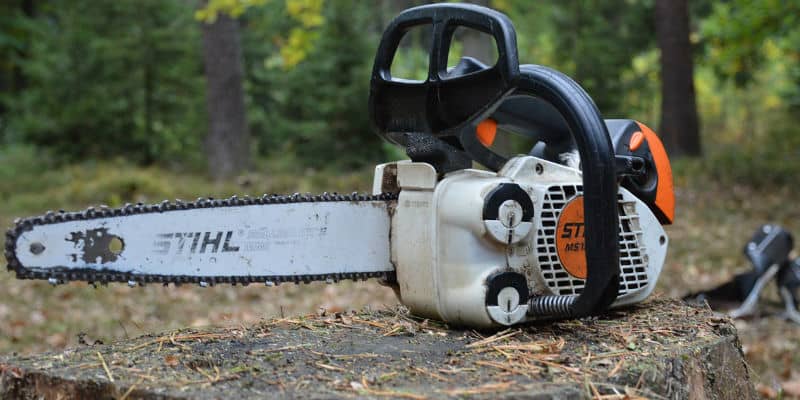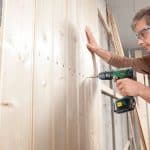Last updated on February 10th, 2022
Our site is reader supported, this means we may earn a small commission from Amazon and other affiliates when you buy through links on our site.
Basic maintenance of a chainsaw – step by step
Regular maintenance of a petrol chainsaw is mandatory for the machine to provide years of service. If you own a chainsaw, you’re very much aware of your tool’s tremendous potential for biting through the timber. Perhaps because contemporary saws are so productive and tend to entrance owners into trusting that everything is going well, it’s easy to take these tools for granted. Many people then end up paying the punishment for disregard as a heavy bill at the local repair shop.
In other cases, some owners may feel intimidated by what looks to be a complex machine and perhaps be wary of interfering with delicate parts of the machine. The truth is, you could do your chainsaw a lot good with crucial basic checks at regular intervals, which anyone with a little knowledge can do. Obviously, it’s better to leave the precision work involving the innards of the machine to the experts, however, a routinely inspected and serviced chainsaw is considerably less prone to require significant repairs than one that has been neglected.
That said, we have put together a quick guide to help you keep your chainsaw in tip-top shape and promote its longevity. If you have purchased yourself a good chainsaw whether it be a petrol chainsaw or a cordless electric chainsaw, then at the very least, sharpening the chain and keeping it well oiled are a must and will save you from having to buy expensive new chains and bars.
Below is a good video showing the basic chainsaw maintenance
Chain tensioning
The first part of servicing your chainsaw involves chain tensioning. Chain tensioning is important for your own safety and the proper condition of the saw. A loose chain can jump off the guide bar and cause injury to the user or damage the machine. An excessively tight chain is no good either because it can cause the guide bar to wear out faster than expected. Correct chain tension is when the chain is in contact with the guide bar yet you can still pull it around comfortably by hand. In order to achieve the right tensioning, be sure to let the chain cool before adjusting it.
Bar maintenance
The most consumable part of a chainsaw is the guide bar. The underside is the area that is especially prone to wear because it does most of the cutting. If you notice that the bar is wearing out quickly, then the problem might be related to incorrect chain tensioning, shoddy lubrication or poor operating practices. To ensure that the bar gets worked evenly, turn the bar each time you change the chain. Regular checks for bar marks and general wear are equally important. If the bar groove isn’t sufficiently profound to hold the drive link or the chain isn’t held straight in the groove, then don’t hesitate to replace the bar.
Chain lubrication is a must
Lack of, or inadequate chain lubrication, is the major cause of premature wearing of chains. It is absolutely essential to keep the chain lubricated to prevent calamitous failures that would result in snapped chain or locking of the drive mechanism. The best way to go is by topping up your lubricating oil every time you refuel the chainsaw.
To check if your saw is well-lubricated, start your chainsaw, hold it over a stump and rev the engine. If a tiny line of oil is left on the stump, then all is good.
Sharpening the chain
This is the most critical part of chainsaw maintenance. Obviously, a chainsaw’s sharpness will become impaired over time, even if you avoid accidentally cutting into materials that reduce sharpness, such as rock and soil. Cutting with a blunt chain strains the equipment and leads to high fuel consumption. Frequent sharpening of the chain can keep it in tip top condition and always ready for the next job.
Bear in mind that various chainsaws require a particular approach when it comes to sharpening. We, therefore, advise checking the manufacturer’s instructions on how to sharpen the chain. Some manufacturers recommend having the chain on their machines sharpened by a professional while others propose the use of specific sharpening devices.
How do you know that your chain needs sharpening? Well, it’s all in the waste material from the saw; wood chips indicate that the chain is sharp, whilst dust-like waste would mean the chain needs sharpening.
Chain sharpening in three easy steps
- Secure the bar in a tight vice and lock the chain.
- Use a round file to sharpen the cutting teeth. Make sure to file each tooth at a right angle to the rollers with smooth pushing strokes. Repeat the process with every other tooth. You’ll need to release the brake now and then in order to access more teeth.
- Once you’ve gone around the chain, loosen the vice and turn the saw around in order to file the teeth on the other side.
Warnings
- Wear safety gloves every time you want to sharpen the chain.
- Never try to file a hot chain. Let it cool first.
- Don’t force the file across the chain. If the chain file doesn’t move smoothly, then the chain is warped and you’ll have to buy a new one.
- NEVER turn on the chainsaw whilst sharpening the chain. Always use your hand to advance the chain.
Additional tips for chainsaw maintenance
- Before every use, make sure the oil tank is full. If sawdust and wood chips accumulate, stop and clean the chain before resuming.
- Check the chainsaw for loose screws, nuts and bolts after every few uses. These components tend to loosen due to the machine’s vibration.
- Clean the air filter every time it gets clogged with dirt and debris. Replace if necessary.
- Check the chain brake instrument for positioning and tightness in order to avoid any kickbacks during operation.
- If you are not planning to use the chainsaw for a few months, empty the fuel from the tank and deplete any oil residue in the carburettor by running the tool until it stops.
In Conclusion
A chainsaw can last through years of punishing service but proper maintenance can ensure it works properly and safely. Even with the above set of maintenance tips, be sure to read your instructions manual for more information regarding your particular tool. Lastly, chainsaws should be handled with respect because they are one of the most dangerous garden tools.



